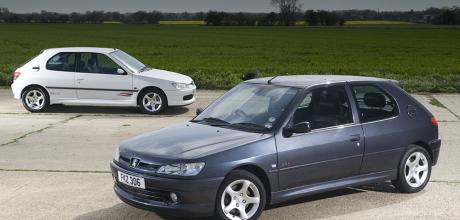1993 Peugeot 306D Turbo
The peak of hatchback design was arguably reached all the way back in 1993 – the year the pretty Peugeot 306 was launched, with a design by Pininfarina. Sure, it might look slightly dated now, but has the simplicity of its lines, its perfect proportions, shapely hatchback or even its dainty door mirrors really been improved upon? Most contemporary hatchbacks have a grille like a surprised emoji.
The D turbo is basically a diesel version of the mildly sporting XS model and was originally launched as a threedoor hatchback, but was later offered with a five-door body and also as an estate. The same engine was used in less sporting 306s, in too many variants to mention here. Launched as a 1.9-litre XUD-powered model in 1994, the 306 gained the newer 2.0-litre HDi commonrail direct injection unit from the second time it was facelifted in 1999. The medium car had a long life, starting in 1993 and replaced by the 307 in 2001. Its underpinnings were clearly engineered by and designed for enthusiasts too. Its combination of deft suspension and small alloy wheels with relatively plump tyres meant the 306 could keep up an eyebrow-raising level of pace along a pitted British B-road. The rear suspension even featured passive rear steering, which was one reason the 306 could slingshot around corners with remarkably little understeer.
The upshot was that even the modestly powerful 306 D turbo was at the top of the heap when it came to hatchback thrills without a GTI badge, and it threw in the possibility of 64.2mpg economy at a steady 56mph. The 91bhp output and 148lb ft torque figure from its turbocharged 1.9-litre XUD diesel engine might not sound like much, but excellent mid-range grunt helped the D turbo feel usefully potent.
It also didn’t have much work to do, with just 1,120kg to haul around. Back road blasts were all about third and fourth gear, surfing the diesel’s wave of torque, and lifting off so engine braking would tuck its slatted nose into the next corner. The brake pedal never required much attention, which was fortunate, as the factory conversion to right-hand drive left the pedals and steering wheel out of line in a fashion that probably wouldn’t be deemed acceptable today. Its interior was simple but not unattractive, with a driver-focussed dashboard and figure-hugging seats, which were one of the best clues to Peugeot’s intention for keen drivers to warm to the D turbo. Its black dials feature timeless white graphics and red needles, but some of the interior upholstery patterns – particularly for special editions – are zany.
Perhaps the highest compliment it’s possible to pay the 306 D turbo, is that it took the launch of the Ford Focus in 1998 for a hatchback to top its talented chassis – a full five years after it launched. So long as its suspension bushes have been replaced, it still offers an enjoyable drive today.


